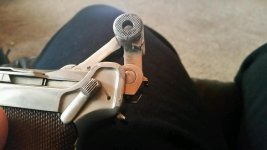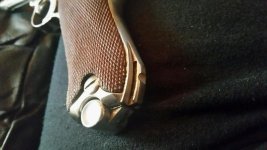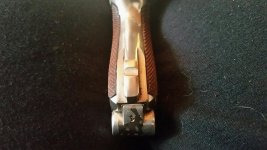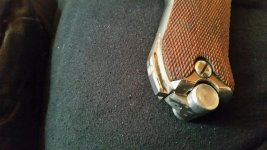Well, call me a sucker, but I went ahead and bought it. Paid $400 OTD - and the seller picked up the $25 BGC/transfer fee. It is an all numbers matching specimen as far as I can tell - frame, barrel, receiver, extractor, safety bar are all matching numbered. Under the frame serial number in front of the trigger guard is what appears to be the lower-case letter "b" in cursive (see photo below).
The whole gun is nickel plated (not chromed) and seems to have been pretty well done, just done a long time ago. It has seen some significant wear since then, resulting in the nickle wearing through and peeling a little on some of the high spots, like the muzzle, the raised ridge outline on the sides of the rear portion of the receiver, and on the aluminum base of the magazine. Interestingly enough the base is also stamped with a 4-digit (serial?) number (see photo below). What does that make it? Military issue? Contemporary with the gun?
It has the GESICHERT marking under the safety lever when in the safe position (photo attached). and the right side of the receiver has 3 stamped or rolled markings (also photo attached). It also has the GELADEN marking on the left side of the extractor (last photo).
So I think I covered all of the areas BB57 asked about - except the one about the "stock lug". I'm not exactly sure what that is referring to, unless it is the cut at the bottom of the backstrap where a stock can be attached. What kind of photos of that are needed? Without that, is there enough info posted here to fully identify it?
I haven't shot it yet, but I put some rounds in it and manually cycled it and all 8 fed and ejected beautifully. The action toggles smoothly, the magazine spring is really stiff, and the bore is mirror bright and sharp, so I'm thinking maybe this one hasn't been shot all that much. The seller's wife inherited it from her grandfather about 10 years ago, and supposedly her grandfather had purchased it a LONG time ago. How much he shot it is unknown.
So, odd as it may sound to some people, I now have one more of my grail guns. I know most people think of grail guns in terms of pristine examples, but that isn't a key point for me. I've wanted a Luger as long as I can remember but never found one that was in the range of what I considered affordable enough to buy. So now I have one.
$400 OTD is a great price, even for a "shooter". I'm not much of a collector and every firearm in my safe gets shot, so I see the value of firearms like this in terms of their representation of the type and the period of history involved. I'd much rather shoot a piece of history rather than just look at it.
-----
Your pistol is a 1914 pattern P.08 Luger. The proof marks have been polished a bit but there are clearly two Weimar era acceptance marks - one for the receiver and a second identical mark for the pistol as a whole. The third mark is a test fire proof mark, and these usually had either "Ar A4" or "WaA4" under the mark.
The pistol also has a 1921 date, and a "b" prefix military serial number. No prefix, an "a" prefix, a "b" prefix or a commercial serial in the 83900 to 89600 range are all correct for a 1920 and 1921 military and police pistols.
The pistol however does not have a Reichswehr property mark on the chamber so it is not a "Military and Police Dated, Army" but rather a "Military and Police Dated, Police" Luger.
The "Military and Police Dated, Army" pistols will bring around $2000 in excellent condition as they are a little less common than the "Military and Police Dated, Police" Lugers which bring around $1500 in excellent condition. They sell for around $400 in "poor" condition. A good restoration would probably sell for around $800.
Your pistol should have a magazine with a wrap around tin plated magazine with a wooden base. The magazine with your pistol appears to be a later 1936-42 Mauser era magazine also a wrap around tin magazine, but with an aluminum base.
In terms of shooting a P.08 Luger, the toggle link action of the P.08 has an undeserved reputation in some circles as being a "weak" design. It isn't, but it does need to have the springs replaced when they get old or wear out.
Consequently, I recommend you put new springs in it since it's been around nearly 100 years and may have never gotten a fresh set of springs.
Then once you have replaced the springs, test fire it with strips of masking tape on the shoulders of the frame where the toggle knobs come to rest. If the tape is being cut by the toggles the load is too strong for the pistol and springs. If the pistol doesn't cycle reliably the load is too weak for the pistol and springs.
The P.08 was not designed for 9mm+P ammo and +P ammo should never be used. However, most standard pressure loads in the 115-124 gr weight range should function well in it, and it's easy to verify that the load is not beating your pistol to death with the masking tape test. With a good load in the 112-124 gr range P.08s will run like well oiled sewing machines and are a real pleasure to shoot.
I also recommend not using the original magazine, especially the original spring. There are good aftermarket magazines available for shooting, and a correct, functioning magazine adds to the value of the pistol. I'd use your Mauser era magazine as trade for a Weimar or WWI era wood base magazine.
-----
This is my 1914 pattern, 1918 dated DWM made P.08 Luger. It's a DWM made 1914 military pistol, which is about as common as it gets and they sell for around $1000 in excellent condition, although the holster that came with it was work about $300 all by itself.
On this side you can see the later style DWM "USS" acceptance mark followed by the Imperial Army proof mark.





